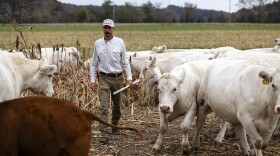American farmers are facing increasingly severe weather that threatens their land and livelihoods. Additionally, decades of producing food, feed and fuel in the heartland have diminished midwestern ecosystems and natural resources. The increasing consolidation of farms has squeezed many small producers out of the business — which ultimately impacts the culture and economy of rural communities.
Regenerative agriculture is a movement that aims to revive the health of the soil and by extension the landscape — and furthermore the small farm economy. The idea is that by changing how farms operate, the farm itself becomes resilient to climate change and can better weather economic storms.
In season one of The Next Harvest, we asked the question: If regenerative agriculture has the power to revive farmland, the environment, and the rural economy — what will it take to scale this model?
Reporter Jana Rose Schleis traveled across Missouri and beyond to hear from researchers, advocates, organizers, business owners and farmers on what needs to change to sustain agriculture — as an industry and a lifestyle.
Season one of The Next Harvest was recognized by the Radio Television Digital News Association with a regional and national Edward R. Murrow Award in the News Series category. The inaugural 7-part installment also received a first-place national award from the Public Media Journalists Association in the Series category.
But the work continues. Season two of The Next Harvest digs into the tools and technologies farmers deploy to enhance conservation and save money. The series also examines the competition for farmland and whether “dual use” strategies can work in the Midwest. KBIA’s Harshawn Ratanpal joins this season to report on how national farm policies help or hinder sustainability efforts.
Throughout each season, The Next Harvest delves into how the agriculture industry can adapt to the climate and economic challenges it faces and how farmers can maintain their businesses and steward their land.
Episodes of The Next Harvest air Wednesdays throughout the fall on KBIA 91.3FM and can be found at KBIA.org.
-
Conservation methods can help rejuvenate farmland, but cost and quality are a concern.
-
Crop insurance provides some coverage for some farmers, but can often be an obstacle to sustainability.
-
Precision agriculture tools aim to reduce impact on environment and save money.
-
Aerial crop planting and treatment takes off across the Midwest.
-
Researchers analyze whether agrivoltaics can work for large-scale crops and cattle.
-
Experiments in agrivoltaics offer a respite to extreme heat, and provide land access for new farmers.
-
Local news series examines new agriculture methods.
-
There’s more to come in 2025 on the obstacles facing agriculture – and potential solutions.
-
Farmers say higher prices are essential to grow food that’s good for the environment
-
Regenerative agriculture can make farmland resilient to climate impacts but requires a large initial investment.











